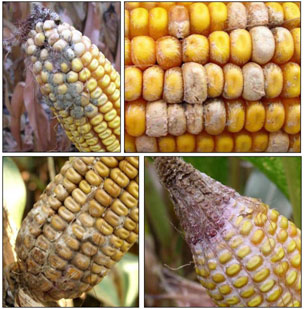Des Moines, Iowa, USA
September 24, 2013

Common ear molds include (clockwise from top left) Aspergillus, Fusarium, Gibberella and Diplodia.
Source: DuPont Pioneer.
A growing season characterized by weather extremes, leading to crop stress during flowering and delayed maturity, has created favorable conditions for classic corn ear molds. DuPont Pioneer experts warn that the environment will become increasingly ideal for ear molds if the weather brings cooler temperatures and periodic rains as we head into harvest. In addition, drought stress and insect injury to the crop provide an avenue for fungi to enter, causing ear molds to establish and spread.
“The carryover of ear mold inoculum from last year’s drought environment is likely minimal; however, growers with a history of molds should carefully scout their fields,” says Bill Dolezal, DuPont Pioneer plant pathology research fellow. “While not significant, we have heard reports of ear molds in Indiana and Illinois, as well as Missouri and Tennessee, this year. Ear molds reduce yield potential, grain quality and feed value.”
While scouting, it is important to identify molds and determine if mycotoxins are present. If mold presence is greater than 10,000 cfu/gram and is of the Aspergillus, Fusarium, Gibberella or Penicillium strains, a mycotoxin screening should be completed. Many crop insurance policies require that you contact your crop insurance agent as samples must be pulled from the field by a loss adjuster prior to the grain being placed in storage. The representative sample must be sent to university plant pathology labs for proper mycotoxin screening and identification.
If 10 percent or more of the ears in the field have a significant amount of mold present on greater than 25 percent of the ear, harvest as soon as possible. The best way to prevent further growth and toxin development is to harvest at or above 20 percent moisture and then dry the corn to 15 percent moisture or less.
When harvesting, be sure to adjust your combine to minimize kernel damage and remove the lightest kernels. Broken kernels often have a higher likelihood of toxin development.
Proper grain drying and storage are critical to minimize further proliferation of existing molds. Grain should be dried to less than 15 percent moisture and cooled below 50 degrees as quickly as possible following harvest. Prior to storage, clean grain to remove any infected kernels, cobs and fines.
If possible, store infected grain separately to avoid putting the entire bin at risk for contamination. Grain should be stored in cool temperatures, preferably around 30 degrees. To maintain condition, regularly monitor and check grain in storage for temperature, moisture and insects. After handling infected grain, thoroughly clean drying bins and equipment to avoid further contamination.
Looking ahead to next year, Pioneer experts provide several tips to manage and decrease the likelihood of corn ear molds. Consider planting regionally adapted hybrids, such as those in the Optimum® AcreMax® product line-up; which offers many hybrid choices with strong traits for above-ground insect protection to help reduce damaged kernels and fungal-spore entry points. Implementing a balanced fertility program, designed for optimum yields, is also beneficial. Crop rotation and residue management can provide substantial disease control as well.
For additional management tips, contact your local DuPont Pioneer agronomist or Pioneer sales professional, or visit www.pioneer.com.
DuPont Pioneer is the world’s leading developer and supplier of advanced plant genetics, providing high-quality seeds to farmers in more than 90 countries. Pioneer provides agronomic support and services to help increase farmer productivity and profitability and strives to develop sustainable agricultural systems for people everywhere. Science with Service Delivering Success®.
DuPont (NYSE: DD) has been bringing world-class science and engineering to the global marketplace in the form of innovative products, materials, and services since 1802. The company believes that by collaborating with customers, governments, NGOs, and thought leaders, we can help find solutions to such global challenges as providing enough healthy food for people everywhere, decreasing dependence on fossil fuels, and protecting life and the environment. For additional information about DuPont and its commitment to inclusive innovation, please visit www.dupont.com.
The DuPont Oval Logo, DuPont™, Science with Service Delivering Success®, Optimum® AcreMax®, and Pioneer® are trademarks or registered trademarks of DuPont or its affiliates.
Herculex® insect protection technology by Dow AgroSciences and Pioneer Hi-Bred, Herculex® and the HX logo are registered trademarks of Dow AgroSciences, LLC.
YieldGuard®, Roundup Ready® and the YieldGuard® Corn Borer design areregistered trademarks used under license from Monsanto company.
LibertyLink® is registered trademark of Bayer.
Agrisure® is a trademark of and used under license from a Syngenta Group Company. Agrisure® technology incorporated into these seeds is commercialized under a license from Syngenta Crop Protection AG.